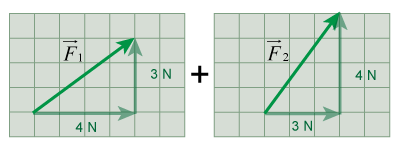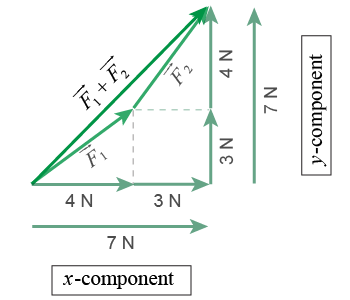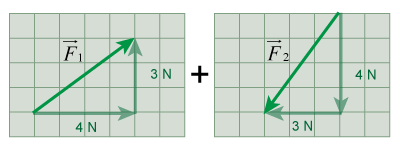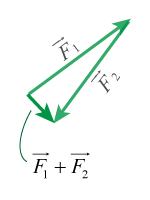|
Vectors are quantities that specify direction as well as amount. Adding vectors is necessary in order to determine the resultant, or net, force on an object (the force that appears in Newton’s second law). Vectors can be added graphically using the “head-to-tail” method. Vectors can be expressed in terms of components; they also can be expressed in terms of magnitude and angle. To add two vectors mathematically, first add their x-components to obtain the x-component of the vector sum; then repeat this procedure with y (and, in the case of three dimensions, z as well). A free-body diagram can help you identify all of the forces acting on an object of interest. 
|
|
vector, vector diagram, magnitude, scalar, resultant vector, component force, component, resolution of forces, sine, cosine, tangent, radian (rad)
|
|
|
|
Review problems and questions |
|

- Using each force vector’s x- and y-components, calculate the sum + indicated here. Use component arithmetic and the graphical “head-to-tail” method. Express your sum graphically and with numbers.


|
 The vector sum + equals (7 N, 7 N). This can be determined graphically, by adding the vectors “head to tail.” It also can be determined by the following steps:
The vector sum + equals (7 N, 7 N). This can be determined graphically, by adding the vectors “head to tail.” It also can be determined by the following steps:
- First, add the x-component of to that of (that is, 4 N + 3 N = 7 N).
- Next, add the y-component of to that of (that is, 3 N + 4 N = 7 N).
The components of the vector sum + are therefore (7 N, 7 N). 
|
- Calculate the magnitude of the vector + from the previous problem.


|
The magnitude of + is approximately 9.9 N. Use the formula for vector magnitude, which is an application of the Pythagorean theorem: Adding 49 to 49 and taking the square root yields a magnitude of 9.9 N. 
|

- Using each force vector’s x- and y-components, calculate the sum + indicated here. Use component arithmetic and the graphical “head to tail” method. Express your sum graphically and with numbers.


|
 The vector sum + equals (1 N, −1 N). The x-component of equals 4 N, and that of equals −3 N. Those add up to 1 N. Meanwhile, the two vectors’ y-components add up to −1 N. Graphically, the “head-to-tail” addition brings us nearly back to the starting point—but not precisely. This implies that the second force almost cancels out the first, but not quite.
The vector sum + equals (1 N, −1 N). The x-component of equals 4 N, and that of equals −3 N. Those add up to 1 N. Meanwhile, the two vectors’ y-components add up to −1 N. Graphically, the “head-to-tail” addition brings us nearly back to the starting point—but not precisely. This implies that the second force almost cancels out the first, but not quite. 
|
- Calculate the magnitude of the vector + from the previous problem.


|
The magnitude of + is approximately 1.4 N. Once more, use the formula for vector magnitude:
The square root of 2 is approximately 1.4, so the magnitude of the resultant vector in this case is about 1.4 N. 
|
- Calculate the magnitude of from the first problem in this review. Next, calculate the magnitude of . Finally, calculate the magnitude of the sum + . Does the magnitude of the vector sum equal the sum of the two individual vectors’ magnitudes? Explain.


|
and each have a magnitude of 5 N. The sum of the magnitudes (5 N + 5 N = 10 N) does not equal the magnitude of the vector sum (which is about 9.9 N). The two sums only would be precisely equal if and pointed in the same direction. (The discrepancy is much more dramatic in the case of Problem 3, where the magnitude of the vector sum, at 1.4 N, is much smaller than 10 N.) 
|
Take a Quiz |

